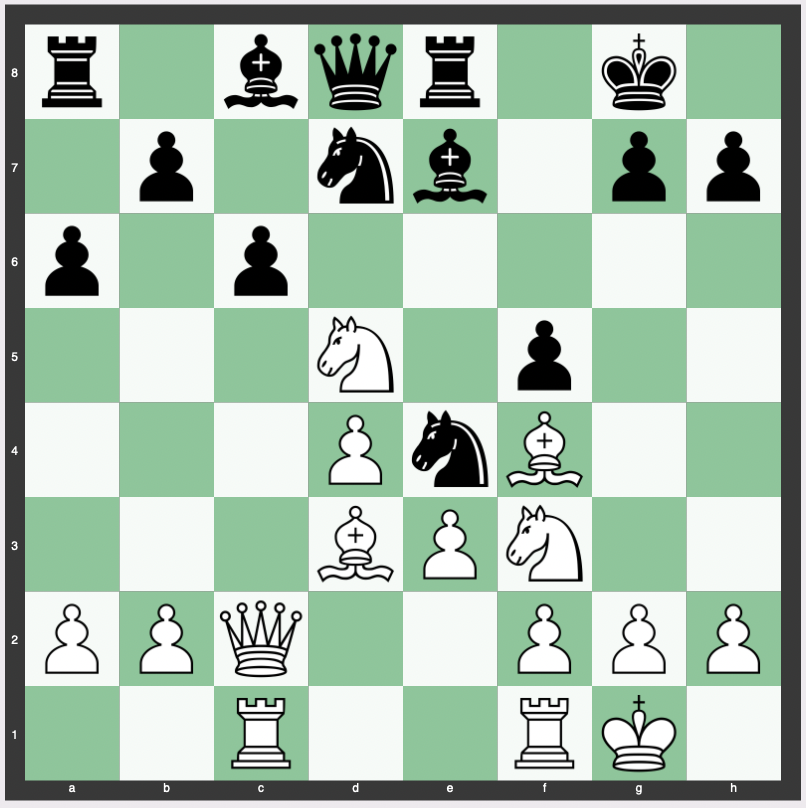The Rubinstein Trap is a renowned chess trap occurring in the Queen’s Gambit Declined, Orthodox Defense.
It is named after the Polish Grandmaster Akiba Rubinstein, who famously fell into the trap in two notable games.
The trap results in Black losing a pawn after the move Nxd5, due to the looming threat of the Black queen being trapped on the back rank by White’s Bc7 move.
Here we look into the various aspects of the Rubinstein Trap, shedding light on its move order, theory, variations, history, suitability for different player levels, and its frequency at the Grandmaster level.
Move Order of the Rubinstein Trap
- d4 d5
- Nf3 Nf6
- c4 e6
- Bg5 Nbd7
- e3 Be7
- Nc3 0-0
- Rc1 Re8
- Qc2 a6
- cxd5 exd5
- Bd3 c6
- 0-0 Ne4
- Bf4 f5?
- Nxd5
The pivotal moment in the Rubinstein Trap comes after Black plays 12…f5?, at which point White can play 13. Nxd5, winning a pawn, and threatening to trap Black’s queen with 14. Bc7.

Theory, Strategy and Purpose of the Rubinstein Trap
The trap is predicated on a tactical blunder by Black, who attempts to consolidate the center with 12…f5? without recognizing the imminent danger.
The sequence leads to a situation where Black loses a pawn and White gains a considerable advantage.
The underlying strategy for White is to capitalize on Black’s mistake, illustrating the importance of tactical awareness in chess.
Variations of the Rubinstein Trap
While the main sequence of the Rubinstein Trap is relatively straightforward, variations can occur based on different responses from Black.
For example, instead of falling into the trap with 12…f5?, Black may choose different moves to avoid the trap altogether.
The presence of these variations allows for flexibility in playing, making it essential for both White and Black to understand the underlying principles of the trap.
Also, black can avoid the trap by moving the bishop to d6.
However, black is already down position-wise.
History of the Rubinstein Trap
The Rubinstein Trap takes its name from Akiba Rubinstein, who fell into it twice, in the games Max Euwe–Rubinstein, Bad Kissingen 1928, and Alexander Alekhine–Rubinstein, San Remo 1930.
Interestingly, Rubinstein was not the first victim of this trap; the first recorded game featuring it is Amos Burn–Heinrich Wolf, Ostend 1905.
The trap’s history reflects the evolution of chess theory and practice, showcasing the enduring relevance of tactical traps.
Is the Rubinstein Trap Good for Beginners or Intermediates?
The Rubinstein Trap can be an effective tool for both beginners and intermediate players.
For beginners, it offers an opportunity to learn about tactical themes and the importance of careful calculation.
For intermediate players, it’s a reminder of the depth of chess, where even a seemingly innocuous move can lead to a significant disadvantage.
However, highly skilled opponents are less likely to fall into this trap, making it less effective at higher levels.
How Often Is the Rubinstein Trap Played at the Grandmaster Level?
At the Grandmaster level, the Rubinstein Trap is rarely seen.
Top players are usually well-versed in common traps, and their keen awareness of tactical possibilities makes it unlikely for them to fall into the Rubinstein Trap.
That said, the principles underlying the trap continue to influence modern play, emphasizing the importance of tactical finesse and in-depth understanding of positional play.
What is the Rubinstein Trap in Chess?
Conclusion
The Rubinstein Trap serves as a fascinating study in chess tactics, strategy, and history.
Named after a Grandmaster who fell victim to it, this trap showcases the delicate balance of power and vulnerability in the game of chess.
From its precise move order to the tactical themes it reveals, the Rubinstein Trap continues to be a valuable lesson for players at all levels.
While rarely seen at the highest echelons of the game, its lasting impact on chess theory ensures that it will remain a subject of interest for students of the game for years to come.
Related


